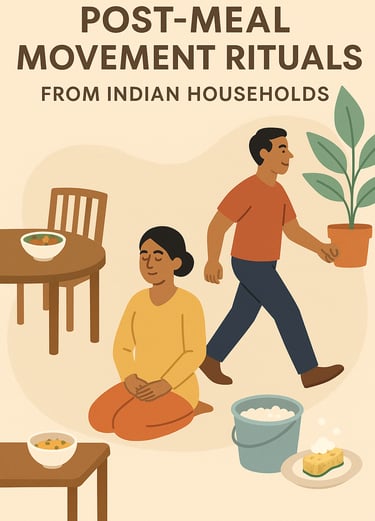Post-Meal Movement Rituals from Indian Households
In many Indian homes, post-meal rituals are not just about tradition — they’re rooted in wisdom that supports digestion, energy balance, and longevity. While modern lifestyles often push us towards screens or sofas after eating, our ancestors had subtler, smarter ways to keep the body moving gently and intentionally after meals. Let’s rediscover these age-old Indian practices and understand how they align with today’s science on digestion and metabolic health.
MOBILITY
5/28/20252 min read


Post-Meal Movement Rituals from Indian Households
In many Indian homes, post-meal rituals are not just about tradition — they’re rooted in wisdom that supports digestion, energy balance, and longevity. While modern lifestyles often push us towards screens or sofas after eating, our ancestors had subtler, smarter ways to keep the body moving gently and intentionally after meals. Let’s rediscover these age-old Indian practices and understand how they align with today’s science on digestion and metabolic health.
🍽️ 1. Why Movement After Meals Matters
Science now confirms what Indian traditions long practiced: gentle movement after meals aids digestion, supports blood sugar regulation, and improves circulation. A sedentary post-meal routine can lead to:
Sluggish digestion (bloating, gas, heaviness)
Insulin spikes
Long-term risks like type 2 diabetes
Even just 2–5 minutes of light movement can make a big difference.
🧘♂️ 2. Traditional Indian Post-Meal Rituals
🪑 Vajrasana (Diamond Pose)
Often seen after meals, especially in South Indian homes.
Sitting on the heels helps increase blood flow to the digestive organs and reduces acid reflux.
Even 5–10 minutes after lunch or dinner improves digestion.
🧹 Sweeping or Light Cleaning
Many homemakers naturally tidy the kitchen or living area after meals.
This subtle activity keeps the body upright and mobile, preventing post-meal sluggishness.
🚶♀️ Walking Around the Courtyard
After lunch or dinner, it’s common in joint families to take a slow walk on the terrace or backyard.
Known as “100 steps after meals” — aligns with modern advice to lower post-meal glucose spikes.
🧺 Watering Plants or Folding Clothes
Gentle actions that require movement without overexertion.
Keeps circulation active and posture neutral.
🧑🍳 Kitchen Chores
Washing dishes, wiping counters — these actions offer light muscular engagement while avoiding seated inactivity.
💡 3. Modern Twists on Traditional Rituals
You don’t need a courtyard or large house to stay active post-meal. Here are modern adaptations:
Soleus Heel Raises (2–3 mins standing in place)
Chair Marches (seated or standing)
Tidy-up Timer: Set a 5-minute timer to clean one corner after meals
Indoor barefoot walk post-dinner for grounding and motion
Stretch Routine: Malasana or gentle spinal twists for evening relaxation
🧬 4. Science Behind These Practices
Modern studies show:
A 2-minute walk after meals can reduce blood sugar by 17–30%.
Sitting in Vajrasana enhances parasympathetic nervous system activity, improving digestion.
Gentle movement prevents postprandial dip — the tiredness that often follows heavy meals.
🌿 5. Cultural Wisdom, Daily Wellness
These movements were never labeled as “exercise” — they were a seamless part of Indian lifestyle. Whether it’s washing banana leaves, serving others, or chatting while walking, these rituals were subtle ways to embed physical activity in everyday routines.
✅ Conclusion: Walk, Sit, Breathe — But Never Slump
What you do after a meal matters. Instead of lounging or reaching for your phone, step into a simple post-meal ritual — from traditional Vajrasana to a short barefoot walk. With just 5 minutes of conscious movement, you align with generations of Indian wisdom and support your modern health goals.
Follow us
platanoorganic6@gmail.com
+919019754079
© 2025. All rights reserved.
FSSAI License no : 21223192000415
Platano Organic Foods
